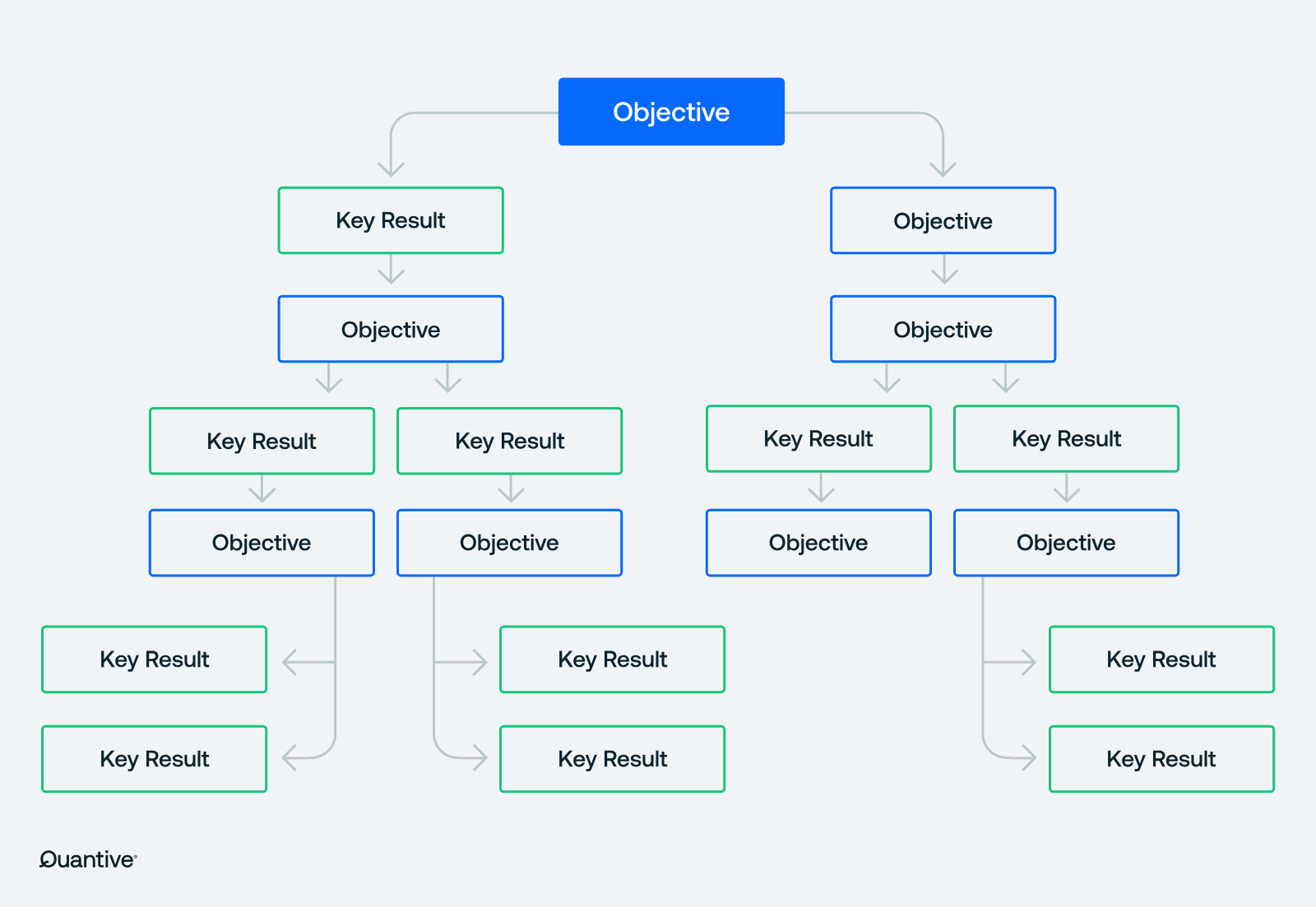Business alignment is a crucial ingredient for success. Without it, your business strategy and the work being done are out of sync, collaboration suffers, and employees feel disconnected from your company’s results. This can lead to wasted efforts and missed growth opportunities.
Despite its importance, leadership teams often struggle with the ‘how’ of creating organizational alignment. Conflicting priorities, ineffective communication, and a mismatch in vision are often at fault. Fortunately, there are solutions to this problem — the objectives and key results (OKRs) methodology being a proven one.
This article highlights how organizational leaders can foster business alignment with OKRs. It’ll provide examples of how to apply this methodology to your organization.
What are OKRs?
OKRs are a methodology for setting and achieving ambitious goals. This goal-setting methodology comprises two key components: objectives and key results. Objectives are short descriptions of what you want to achieve, serving as guiding stars representing desired outcomes. Each objective is accompanied by two to four key results, which are quantitative metrics that measure goal progress and indicate the level of achievement.
Learn more about the OKR methodology

What is business alignment?
Alignment in business involves harmonizing internal and external elements of your company toward organizational goals. It means internally linking your strategy, resources, systems, and processes, and closely monitoring customers, market trends, and competitors externally.
When you synchronize all elements for business alignment, your company works as a cohesive unit. Everyone is rowing in the same direction towards a shared, customer-centric destination.
5 examples of alignment in business
Let’s examine five of the most important types of business alignment to get a better picture of what plays into overall alignment.
- Strategic alignment: Ensuring all aspects of your company’s operations are in line with your overarching business strategy, maximizing impact by funneling efforts into high-priority areas
- Customer alignment: Focusing on understanding and meeting customer needs to keep them satisfied and loyal
- Business-IT alignment: Integrating IT initiatives and systems with your overall business strategy for leveraging technology effectively
- Leadership alignment: Ensuring top-level executives agree regarding the company’s vision and goals to create a cohesive culture
- Cultural alignment: Fostering a consistent and positive organizational culture that supports the company’s values and goals to create employee collaboration and satisfaction
Why business alignment is critical
Business alignment brings a wealth of benefits to the table, including:
- Increased goal attainment: When everyone is marching in the same direction, you ensure efforts, resources, and decisions align with your company objectives.
- Enhanced adaptability: Aligned businesses can swiftly adapt to market changes, becoming agile, customer-focused, and in tune with evolving trends. This enables them to seize opportunities and navigate risks to maintain a competitive edge.
- Heightened decision-making capabilities: Aligned objectives, strategy, and cross-functional collaboration lead to better decision-making. According to a 2020 study, organizational alignment positively impacts decision quality, time, and acceptance.
- Boosted efficiency: Business alignment minimizes inefficiencies, enables seamless processes, optimizes resource utilization, and leads to impressive growth. Highly aligned companies grow revenue 58% faster and are 72% more profitable than misaligned ones, according to a study by LSA Global.
- Higher employee engagement: A workplace where individual goals contribute to the greater mission fosters engagement and commitment. When employees feel their work matters, engagement increases by 3.6 times.
- Improved customer satisfaction: By aligning your business with customers' needs and preferences, you create satisfaction, trust, and loyalty. Highly aligned companies outperform unaligned counterparts in customer satisfaction by 3.2-to-1.
- Better collaboration: Business alignment leads to better teamwork, efficient collaboration, and shared understanding, trust, and coordination. According to Gallup, top connected teams experience fewer instances of absenteeism (41%), increased well-being (66%), and less employee turnover (59%).
“Once each team member's strengths are aimed at the same purpose and teams are aligned on goals, this is where true excellence and success happens.”
- Gallup
What does effective business alignment require?
Now that we’ve covered what business alignment is and why it matters, let’s look at what it requires. As a leader, it starts with clarifying and facilitating the following elements:
- A well-defined vision and mission: Your North Star guiding purpose and direction, aligning cross-function efforts
- A strategic plan: A solid plan outlining long-term goals and the steps to achieve them, with embedded flexibility to adapt as needed
- Leadership support and commitment: Leading by example to inspire, guide, and motivate employees to stay on track
- Performance metrics: Tracking progress metrics to ensure continued focus on strategic goals and identify areas of improvement
- Communication and transparency: Openly sharing goals, progress, and challenges regularly to foster a culture of collaboration
- Shared outcomes: Encouraging teamwork and cooperation among teams and departments to ensure cross-functional efforts work purposefully
- An adequate organizational structure: Clear reporting lines, roles, and responsibilities streamline decision-making and promote focused efforts
- Real-time insights: Using up-to-date information to adjust strategies to changing market conditions and customer demands
- Suitable technology: Leveraging the right tools to enhance communication, integrative capabilities, data sharing, and overall business-IT alignment
How OKRs drive business alignment
By providing a strategic methodology that links high-level company goals to individual team objectives, OKRs create a unified direction for your organization. In fact, 61% of companies use OKRs precisely for this reason.
Let’s see how OKRs support essential elements vital to business alignment.
Clarify vision and mission
With OKRs, your mission and vision become the heart of your organization’s processes. Each team sets their OKRs in line with the company’s objectives, ensuring everyone’s working toward the same destination. This helps your employees understand the bigger impact of their daily tasks and how they contribute to the company’s success.
Provide an actionable strategic plan
OKRs make strategic plans more actionable, bridging the gap between vision and strategic execution. Setting measurable and time-bound objectives allows you to track progress, identify obstacles, and adjust to stay on track. Regular check-ins keep teams focused, ensuring effective resource allocation on an ongoing basis.
Ensure company-wide execution through leadership support and commitment
As a leader, your active participation and commitment to OKRs are pivotal in driving business alignment. You can keep teams aligned toward critical priorities by clearly stating your organization’s ambitious objectives. Leadership involvement can take OKRs from mere words to essential priorities, motivating teams and fostering goal accountability.
Encourage a regular cadence for reviewing performance metrics
OKRs promote regular review of progress using key result check-ins, allowing you to identify misalignments and deviations in metrics early on. This lets you promptly realign efforts to stay on course to achieving primary business objectives.
Facilitate communication and transparency
Open communication and transparency are core principles of OKRs. By making objectives and key results visible to everyone, your organization stays informed about goals and processes, ensuring shared outcomes are a top priority. This open dialogue fosters engagement and allows employees to see how their collective efforts contribute to broader team and company objectives.
Drive collaboration with shared outcomes
OKRs encourage cross-functional collaboration through shared objectives. With clarity on what each team is working on, they can better align their efforts to ensure ultimate objectives are achieved, leading to greater efficiency and lateral thinking skills.
Reduce silos across organizational structures
OKRs help clarify roles, responsibilities, and how possible synergies across departments. They compel teams to skip working in isolation and connect in a way that optimizes performance. As a result, silos are reduced, with cross-departmental teams working cohesively to share knowledge, enhance productivity, and eliminate redundancy.
Boost agility with real-time insights
OKRs enhance adaptability and flexibility through rapid course correction and cascading adaptability. OKR goals can be reassessed and readjusted throughout the OKR cycle when needed, enabling your organization to stay dynamic and responsive to changing circumstances.
Enhance data-driven decisions with OKR software
OKR software, as a centralized platform for OKRs, can streamline goal-setting by enabling the effortless cascading of objectives from top to bottom. They also facilitate real-time progress tracking, data-driven insights, and accountability, enabling informed decisions that align teams around the right initiatives.
See more benefits of using OKRs in business

OKRs in practice: Strengthening strategic alignment
To demonstrate the applicability of OKRs, let’s see how you can use the OKR methodology to drive a crucial type of alignment — strategic alignment.
Picture this: you’re an executive at a tech company that wants to expand its market share in the retail banking industry.
First, you’d discuss with the entire leadership team to create your company OKR.
Company OKR
- Objective: Become the dominant force the retail banking industry by skyrocketing our market share
- Key result 1: Acquire at least five major clients from the retail banking industry
- Key result 2: Increase revenue from existing retail banking industry clients by 25%
- Key result 3: Launch a targeted campaign that reaches 70% of the retail banking industry’s key decision-makers
After setting this company OKR, you’d cascade it down the organization. This involves collaborating with department heads to ensure departmental OKRs support the company’s OKR.
For example, the sales team may end up agreeing on the following OKR:
Sales department OKR
- Objective: Acquire at least five major clients from the retail banking industry
- Key result 1: Secure long-term contracts with three top-tier banks with a minimum duration of 2 years
- Key result 2: Develop a targeted list of 50 qualified retail banking industry leaders and leverage a personalized outreach campaigns to increase conversions by 20%
- Key result 3: Leverage existing client relationships and industry connections to establish a referral program that generates at least two new leads per month
Using this departmental sales OKR, sales representatives can create individual OKRs to ensure alignment at the granular level. This may look like:
Sales representative OKR
- Objective: Contribute to acquiring major finance industry clients
- Key result 1: Generate 50 qualified leads from the retail banking industry
- Key result 2: Assist in securing long-term contracts with 3 major retail banks in the UK
- Key result 3: Achieve a 25% increase in revenue from finance industry clients
This cascading process is like building a chain of aligned objectives that connect everyone’s efforts with the company’s ultimate vision.
Yet, OKRs aren’t just a one-and-done process.
For strong strategic alignment, regular check-ins and reviews are a must — they help you track OKR progress, address challenges, and foster collaboration. The entire organization stays accountable and focused on the primary goal.

Strengthening business alignment with OKR software
While high-performing companies have diverse approaches to managing and tracking OKRs, the primary distinction is their higher usage of OKR software, per the Global State of OKRs Trends Report 2023.
OKR software improves alignment, reduces manual errors, brings transparency to initiatives, and empowers businesses to scale their OKR program from teams to the entire organization. The right OKR software improves alignment and streamlines the OKR process by making it scalable, accessible, and effortless.
When choosing a suitable OKR software for your organization, look for these key features that will drive your alignment to new heights:
- Visible alignment: Provide an easy way to visualize the connection across your entire organization.
- Flexible OKR alignment: Support complex alignment beyond your org chart and make adapting to changes in the market a breeze, as your teams can quickly realign objectives to shifts in priorities
- Transparent OKR ownership: Fosters accountability with OKRs, driving responsibility, dedication, and collective alignment
- Cascading OKRs: Facilitates top-to-bottom coordination, with everyone aligned toward a united company goal
- Real-time visibility into OKRs and OKR progress: Enables cross-functional teams to access and track OKRs in real-time, making sure everyone is on the same page
- Dashboards and progress reports: Helps teams stay informed about organizational performance in real-time
- Integrations: Allows OKRs to seamlessly fit into your organization, reducing manual effort while keeping progress up to date
Wrapping up
Business alignment is vital to staying ahead, ensuring collaborative efforts, and driving informed decision-making. As a powerful tool that supports all capabilities needed for alignment, you can use the OKR methodology to drive alignment across the board.
OKRs provide a structured path for creating alignment in business — from planning to execution and monitoring. They turn goals into action, encourage company-wide execution, and foster communication and transparency. With OKRs, collaboration flourishes, silos dissolve, agility thrives, and data-driven decision-making becomes second nature.
For effortless alignment using OKRs, you can turn to OKR software. A dedicated OKR solution offers real-time visibility, flexibility, and seamless cascading of objectives. It keeps your organization focused, accountable, and aligned toward a unified goal with minimal manual input.
By leveraging OKRs and the right OKR management solution, you turn the challenge of business alignment into a dynamic capability that propels your business forward to heightened success.
Quantive empowers modern organizations to turn their ambitions into reality through strategic agility. It's where strategy, teams, and data come together to drive effective decision-making, streamline execution, and maximize performance.
As your company navigates today’s competitive landscape, you need an Always-On Strategy to continuously bridge the gap between current and desired business outcomes. Quantive brings together the technology, expertise, and passion to transform your strategy from a static plan to a feedback-driven engine for growth.
Whether you’re a visionary start-up, a mid-market business looking to conquer, or a large enterprise facing disruption, Quantive keeps you ahead — every step of the way. For more information, visit www.quantive.com.

